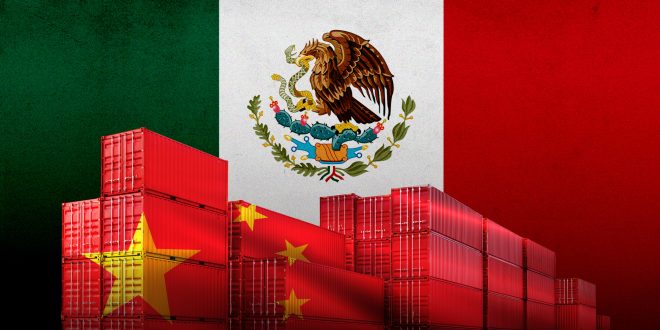China has become a major force in Latin America in recent years, and its investment tactics have changed the economic landscape of the area. Because of its advantageous location, strong manufacturing capabilities, and trade agreements like the U.S.-Mexico-Canada Agreement (USMCA), Mexico is one of the most attractive countries in Latin America for Chinese money.[1] China intends to deepen its economic relations and expand its influence in the region, as seen by the various sectors of manufacturing, renewable energy, technology, and infrastructure that it has invested in Mexico. For Mexico and its neighbors, this expanding alliance presents both chances for economic expansion and difficulties about national security and economic sovereignty. As China continues to expand its influence throughout Latin America, evaluating the effects of these investments is essential for determining how the dynamics of the area will develop going forward.
The Rise of Chinese FDI in Mexico
Chinese investment in Mexico has increased dramatically, with the country emerging as a major player in the manufacturing sector. As a result of this development, which reflects changes in global supply chains, China is now one of the countries supplying foreign direct investment (FDI) to Mexico at the fastest rate.[2] The US$5 billion investment made by Lingong Machinery Group (LGMG) to construct a cutting-edge manufacturing facility and industrial park in the industrial powerhouse of Nuevo León serves as an excellent illustration. China’s aim to take advantage of Mexico’s proximity to the U.S. market for duty-free access is apparent through such investments amid concerns surrounding U.S.-China trade.[3] These initiatives highlight the value of nearshoring tactics as Chinese businesses increase their operations in Mexico, boosting the country’s economy, creating jobs, and advancing technology while solidifying Mexico’s place in the world’s industrial networks.[4]
Mexico and U.S.-China Trade War
Mexico’s economic path has been greatly impacted by the trade and FDI war between the U.S. and China. A lot of businesses have adopted nearshoring, shifting production closer to the U.S. to reduce risks, in reaction to rising tariffs and supply chain interruptions. This change has increased Mexico’s attractiveness as a strategic site for companies looking to take advantage of the preferential access to the North American market provided by the USMCA. Mexico’s position in the global supply chain has been further cemented because of an increase in FDI from businesses looking to launch or grow operations.[5]
Beneficiary of Trade Diversion
A major gainer of the trade diversion brought about by the trade war between the U.S. and China is Mexico. For the first time in the last 20 years, China lost its top spot as the nation’s exporter to the U.S. to Mexico in 2023. October 2023 saw a 17.5% increase in U.S. imports from Mexico and a 7.2% decrease in imports from China.[6] Approximately US$26 billion more in Mexican exports to the U.S. might result from these realignments, according to UNCTAD projections.[7] With increased FDI, stronger economic linkages to the U.S., and an expanded industrial base, Mexico is well-positioned to adapt its trading environment in the face of shifting global supply chains.[8]
Nearshoring Trend
Chinese investments in Mexico have surged due to the nearshoring trend, mainly because of the desire to take advantage of the USMCA and obtain duty-free access to the U.S. market.[9] This tactical change has resulted in significant investments, establishing Mexico as a vital location for Chinese businesses looking to lower tariffs and optimize supply chains. Examples of Mexico’s increasing significance as a manufacturing base for Chinese companies are the US$5 billion investment made by Lingong Machinery Group in Nuevo León and the US$1 billion solar facility constructed by Trina Solar. Furthermore, corporations like BYD Auto are contemplating the establishment of assembly factories, and industrial parks like the Hofusan Industrial Park are being created with the express purpose of accommodating Chinese enterprises. Mexico’s industrial foundation is strengthened by this investment inflow, which also highlights Mexico’s strategic significance in North American commerce.[10]
Key Drivers of Chinese Investment
The swift expansion of Chinese investment in Mexico is driven by various variables that have a fundamental impact on the economic landscape of the region. The trade tensions between the U.S. and China have led Chinese enterprises to look for alternate areas for manufacturing to avoid U.S. tariffs.[11] The Section 301 tariffs, imposed during the Trump administration, include 7.5% on US$120 billion worth of Chinese goods, 15% on certain products, and 25% on about US$250 billion in imports. Tariffs can be even higher for specific industries, such as a recent 100% tariff on Chinese electric vehicles (EVs).[12] Additionally, Trump has proposed a 100% tariff on EVs made in Mexico by Chinese companies if re-elected. Other tariffs, like Section 201, also apply to specific products, and pre-existing tariffs remain in place.[13]
These trade barriers have significantly impacted shipping costs, driving Chinese companies to invest in Mexico to sidestep these tariffs. Mexico’s proximity to the U.S. and its role in the USMCA trade agreement make it an attractive alternative for maintaining U.S. market access.[14] Furthermore, as Chinese businesses look to reduce the risks associated with lengthy shipping routes and unstable geopolitical environments, nearshoring has grown in popularity.[15] Mexico’s border states, with their safe atmosphere, advantageous tax structures, and strong infrastructure, add to the country’s allure as a top location for Chinese investment.[16] As a result, Chinese direct investment in Mexico grew by 48% in 2022,[17] with plans for US$12.6 billion in further investment announced in 2023.[18]
Impact on Key Sectors
China’s increasing investments in Mexico, especially in critical manufacturing areas, are indicative of its drive to increase its market share in North America. An important illustration of this is Tesla’s recent announcement that it will construct a US$5 billion assembly plant close to Monterrey. This highlights Mexico’s critical position in the global supply chain for electric vehicles (EVs) and the shift to sustainable mobility. The initiative by Lingong Machinery Group (LGMG) to build a 25-acre industrial park for transportation and construction equipment is another example of China’s increasing influence in Mexico’s industrial machinery market.
China invests in more than just machinery and automobiles. Significant Chinese funding is also being drawn to the solar energy sector. Trina Solar, for example, intends to invest up to US$1 billion in a new facility in Nuevo León, highlighting Mexico’s strategic significance as a hub for manufacturing in a variety of industries. These investments, motivated by China’s objective of obtaining duty-free access to the U.S. market through the USMCA,[19] improve bilateral ties while broadening Mexico’s industrial landscape.
U.S. National Security and Chinese Investments in Mexico
Concerns about national security are being raised in the U.S. due to China’s increasing investment in Mexico, especially in vital industries including technology, mining, telecommunications, and electric vehicles. The presence of Chinese companies such as Huawei and China Unicom in Mexico’s telecommunications network has raised concerns regarding the safety of American companies doing business there as well as possible dangers to U.S. cybersecurity. The security situation is further complicated by the fact that businesses such as China Communications Construction Company (CCCC) continue to work on significant infrastructure projects in Mexico in defiance of U.S. sanctions.[20]
The U.S.’ strategic interests in North America may be weakened by China’s growing economic sway in Mexico. By presenting itself as Mexico’s substitute partner, China might undermine American hegemony in the area. Concerns have also been expressed regarding the potential effects of Chinese involvement in Mexican industries on intelligence gathering, particularly with reference to non-state entities that could endanger U.S. security. Concerns that China’s growing might may jeopardize U.S. security are heightened by potential links between Chinese organizations and Mexican organized crime.[21]
Experts have suggested various measures to reduce these hazards. To evaluate security risks, one recommendation is to create a foreign investment screening procedure in Mexico that is comparable to the Committee on Foreign Investment in the U.S. (CFIUS). Enhancing information-sharing channels on the dangers of non-market economies is also essential, especially for vital infrastructure industries.[22] Furthermore, the U.S. needs to take critical action to prevent China’s expanding economic influence in Mexico, including strengthening border controls, bolstering security cooperation, and confronting organized crime. The U.S. will probably prioritize combating China’s influence as the USMCA evaluations and bilateral negotiations draw near.[23]
Reasons for China’s Growing Investment in Mexico
There are multiple strategic reasons for the notable increase in Chinese investments in Mexico. Due to Mexico’s proximity to the U.S. and its trade agreements, especially the USMCA,[24] Chinese enterprises can take advantage of preferential access to the lucrative North American market by avoiding tariffs. Mexico is a desirable production alternative since it offers a competent labor force at a cheaper cost than in China, as well as an affordable industrial environment.[25]
To lessen their dependence on domestic production and guard against disruptions brought on by geopolitical unrest, Chinese businesses are likewise broadening their supply networks.[26] This tendency supports infrastructure development in accordance with China’s worldwide policy, as does the Belt and Road Initiative (BRI). These investments are changing Mexico’s industrial landscape and strengthening economic links with China, particularly in areas like manufacturing, transportation, and energy.[27]
Challenges
The U.S. has serious national security and economic worries about China’s growing involvement in Mexico. The main concern is that, in the context of escalating trade tensions, Chinese businesses would use Mexico to get around U.S. tariffs. Chinese companies can export goods to the U.S. under the USMCA without paying the high tariffs imposed on Chinese imports by setting up production facilities in Mexico.[28] This technique may be viewed by American officials as an unfair economic tactic, which could jeopardize U.S. trade policy and could spark further disagreements between the U.S. and Mexico.[29]
Apart from fiscal issues, Chinese companies’ investments in vital industries like ports, telecommunications, and infrastructure give rise to security worries. Because of the strategic significance of these sectors, there are concerns that Chinese businesses, particularly those with connections to the Chinese government, may represent security hazards by engaging in cyberespionage or exerting control over local data networks.[30] Furthermore, there are concerns about competition raised by Chinese enterprises entering Mexico’s industrial environment. These companies may outcompete local businesses in industries like manufacturing and technology, which would stifle innovation and economic progress. The scenario is made more complicated by the financial support that Chinese firms frequently receive from their government, underscoring the complex ramifications of China’s expanding influence in Mexico for both regional economic stability and U.S. security.[31]
Opportunities
Chinese investment offers substantial prospects for Mexico’s economic expansion despite the obstacles. It is anticipated that Chinese investors will contribute US$12.6 billion to modernization efforts in several industries, including manufacturing, technology, and infrastructure, just in 2023.[32] This capital inflow boosts Mexico’s economy overall and makes it more competitive in global markets. Notably, these investments are causing significant development in places like Nuevo León, which is changing Mexico’s industrial landscape and enabling necessary infrastructural improvements for long-term economic viability.[33]
Furthermore, more Chinese investment helps Mexico create jobs and transfer technology. Thousands of job opportunities for Mexican workers are being created by Chinese enterprises through the construction of new industries and infrastructure projects.[34] Furthermore, these businesses have strengthened Mexico’s industrial capacities by introducing cutting-edge technologies and production methods, especially in high-tech industries like solar energy and the production of electric vehicles. Mexico is lessening its dependency on American investments by drawing in Chinese capital and broadening its foreign investment portfolio. Mexico’s foreign investment strategy is more stable because of this diversification, which acts as a buffer against both economic and geopolitical volatility.[35]
Implications for the Future
Chinese investment in Mexico is expected to continue its upward trend given the country’s strategic advantages and the ongoing trade disputes between the U.S. and China. Mexico is a desirable location for Chinese companies looking to get around American tariffs and obtain duty-free access to North American markets because of its proximity to the U.S., favorable trade accords like the USMCA, and cheaper production costs.[36] This change is transforming trade patterns in North America and strengthening Mexico’s position in global supply chains, making it an essential bridge connecting the economies of China and the U.S.[37]
To effectively capitalize on the prospects afforded by Chinese investment, officials in Mexico and the U.S. need to adopt calculated measures to mitigate any possible obstacles. To safeguard national interests, this entails putting in place explicit limitations on foreign investment in vital industries like energy, infrastructure, and telecommunications.[38] Furthermore, Mexico and the U.S. will need to work together more closely on security matters, particularly in sensitive areas, as Chinese involvement grows. To satisfy the needs of the developing industries supported by Chinese investment, Mexico should likewise place a high priority on workforce development. For Mexico’s future, it will be crucial to strike a balance between managing long-term dangers and geopolitical obstacles, as well as the economic benefits of Chinese investment.[39]
Conclusion
The main cause of the recent increase in Chinese FDI in Mexico is the ongoing trade spat between China and the U.S. Chinese enterprises can now access the lucrative U.S. market without having to pay tariffs. This investment boom has not only changed Mexico’s economic environment but also established the nation as a major hub for manufacturing and logistics in international supply chains. Chinese businesses also gain from Mexico’s advantageous location in relation to the U.S., which allows for quicker delivery times and cheaper transportation costs.
Still, there are drawbacks to this movement. The geopolitical tensions between China and the U.S. may make the investment climate unpredictable, which could discourage future investments and influence corporate operations in Mexico. Mexico also must manage its complicated relationship with the U.S., which is its biggest trading partner, while promoting its expanding economic links with China. There are hazards associated with this dual strategy; changes in trade or diplomatic ties may endanger Chinese investments as well as Mexico’s economic stability.
Increasing domestic and international investors’ legal protections will contribute to a more confident business climate. Enhancing workforce development programs is also essential to getting local labor ready for the demands of growing industries. Mexico can leverage Chinese FDI to strengthen its manufacturing sector and preserve its important position in the trade dynamics of North America by actively managing its economic connections. Mexico should place a high priority on stability and openness in its foreign investment regulations to maximize the opportunities presented by Chinese investment while lowering any potential hazards.
[1] “China’s presence in Latin America has expanded dramatically,” The Economist, July 4, 2024, https://www.economist.com/the-americas/2024/07/04/chinas-presence-in-latin-america-has-expanded-dramatically.
[2] “Hot Topics in International Trade – June 2024 – Overcoming Obstacles: Challenges Faced by China’s FDI in Mexico,” JD Supra, June 11, 2024, https://www.jdsupra.com/legalnews/overcoming-obstacles-challenges-faced-1316457/.
[3] Ibid.
[4] Noi Mahoney, “Chinese manufacturer investing $5B to expand production in Mexico,” Freight Waves, October 18, 2023, https://www.freightwaves.com/news/chinese-manufacturer-investing-5b-to-expand-production-in-mexico.
[5] “Mexico takes the US side in potential trade battles with China and seeks to boost local content,” AP, October 9, 2024, https://apnews.com/article/mexico-china-trade-battle-us-6efdaad668d3a3ba0c89c59da444a96c.
[6] Paloma Duran, “China’s Growing Interest in Mexico Not Without Risks,” Mexico Business News, May 23, 2024, https://mexicobusiness.news/trade-and-investment/news/chinas-growing-interest-mexico-not-without-risks.
[7] Gilberto García-Vazquez, “The US-China trade is causing some companies to look for Mexico as an alternative to sourcing from China,” OEC, https://oec.world/en/blog/when-china-and-the-us-have-a-trade-war-mexico-wins.
[8] “Mexico is a Beneficiary of the US-China Trade War,” TECMA, https://www.tecma.com/mexico-is-a-beneficiary-of-the-us-china-trade-war/.
[9] Kenneth Rapoza, “Mexico is Growing as New China hub; 2024 Exports Already Breaking Records,” Coalition for a Prosperous America, March 19, 2024, https://prosperousamerica.org/mexico-is-growing-as-new-china-hub-2024-exports-already-breaking-records/.
[10] Ibid.
[11] Hale Utar, Alfonso Cebreros, and Luis Torres, “How Mexico emerged as a key player in the US-China trade war,” VoxDev, April 26, 2024, https://voxdev.org/topic/trade/how-mexico-emerged-key-player-us-china-trade-war.
[12] Connor Pfeiffer and Ryan C. Berg, “Solving the China Challenge in Mexico,” Foreign Policy, July 24, 2024, https://foreignpolicy.com/2024/07/24/china-mexico-united-states-partnership-infrastructure-investment/.
[13] Rapoza, “Mexico is Growing as New China hub; 2024 Exports Already Breaking Records.”
[14] Raymond Kelley, “Economic Growth Results from Chinese Investments in Mexico,” Rogers & Brown, June 19, 2024, https://www.rogers-brown.com/news/economic-growth-results-from-chinese-investments-in-mexico/.
[15] “Hot Topics in International Trade – June 2024 – Overcoming Obstacles: Challenges Faced by China’s FDI in Mexico,” JD Supra, June 11, 2024, https://www.jdsupra.com/legalnews/overcoming-obstacles-challenges-faced-1316457/.
[16] Ibid.
[17] Minlu Zhang, “China’s trade with Mexico, FDI on the rise,” China Daily, August 22, 2024, https://www.chinadaily.com.cn/a/202408/22/WS66c69619a31060630b9245c5.html.
[18] Pfeiffer and Berg, “Solving the China Challenge in Mexico.”
[19] Mahoney, “Chinese manufacturer investing $5B to expand production in Mexico.”
[20] Pfeiffer and Berg, “Solving the China Challenge in Mexico.”
[21] Alan Cunningham, “Protecting the Hemisphere: Safeguarding US Interests and Prioritizing Partnerships for a Stable Hemisphere,” Journal of Indo-Pacific Affairs, May 8, 2024, https://www.airuniversity.af.edu/JIPA/Display/Article/3768220/protecting-the-hemisphere-safeguarding-us-interests-and-prioritizing-partnershi/.
[22] Ibid.
[23] Pfeiffer and Berg, “Solving the China Challenge in Mexico.”
[24] Luis Torres and Aparna Jayashankar, “Mexico awaits ‘nearshoring’ shift as China boosts its direct investment,” Federal Reserve Bank of Dallas, April 14, 2023, https://www.dallasfed.org/research/swe/2023/swe2303.
[25] Kelley, “Economic Growth Results from Chinese Investments in Mexico.”
[26] Pfeiffer and Berg, “Solving the China Challenge in Mexico.”
[27] Kelley, “Economic Growth Results from Chinese Investments in Mexico.”
[28] Sherrod Brown, “Brown Calls on Biden Administration to Stop China From Breaking Into USMCA Trade Agreement,” September 19, 2024, https://www.brown.senate.gov/newsroom/press/release/brown-calls-on-biden-administration-to-stop-china-from-breaking-into-usmca-trade-agreement#:~:text=China%20is%20actively%20avoiding%20U.S.,trade%20abuses%20threaten%20American%20production.
[29] Pfeiffer and Berg, “Solving the China Challenge in Mexico.”
[30] Ibid.
[31] Karen Lellouche Tordjman, Eduardo León, Michael McAdoo, Max Pulido, and François-Xavier Thiebaud, “The Shifting Dynamics of Nearshoring in Mexico,” BCG, September 5, 2024, https://www.bcg.com/publications/2024/shifting-dynamics-of-nearshoring-in-mexico.
[32] Maggie Switek, “The Facts behind China’s Role in Mexico’s Wealth Production and the Value of US-Mexico Cooperation,” Milken Institute, August 14, 2024, https://milkeninstitute.org/article/facts-behind-chinas-role-mexicos-wealth-production-and-value-us-mexico-cooperation.
[33] “Why Chinese companies are flocking to Mexico,” The Economist, November 23, 2023, https://www.economist.com/business/2023/11/23/why-chinese-companies-are-flocking-to-mexico.
[34] Enrique Hernandez-Pulido and Juan D. Arau, “Nearshoring in Mexico: Some Basics for Chinese Companies,” Procopio, March 15, 2024, https://www.procopio.com/nearshoring-mexico-chinese-companies/.
[35] Kenneth Rapoza, “China’s Auto Sector Is Moving to Mexico; 12 New Manufacturing Plants Set Up Since 2019,” Coalition for a Prosperous America, July 11, 2024, https://prosperousamerica.org/chinas-auto-sector-is-moving-to-mexico-29-new-manufacturing-plants-set-up-since-march-2023/.
[36] Lori Ann LaRocco, “In U.S. trade war with China, Mexico is emerging as the big winner,” CNBC, September 20, 2024, https://www.cnbc.com/2024/09/20/china-mexico-backdoor-trade-booms-in-trump-biden-tariff-era.html.
[37] Joint Economic Committee, “Strengthening North American Supply Chains and Trade Benefits the U.S. Economy,” September 4, 2024, https://www.jec.senate.gov/public/index.cfm/democrats/2024/9/strengthening-north-american-supply-chains-and-trade-benefits-the-u-s-economy.
[38] David A. Gantz, “What Does Mexico’s Impending Return to Single-Party Governance Mean for Attracting FDI?,” Rice University’s Baker Institute for Public Policy, June 25, 2024, https://www.bakerinstitute.org/research/what-does-mexicos-impending-return-single-party-governance-mean-attracting-fdi.
[39] Amy L. Glover Drake, “Nearshoring, An Opportunity that is Mexico’s to Lose,” Wilson Center, April 18, 2024, https://www.wilsoncenter.org/article/nearshoring-opportunity-mexicos-lose.





